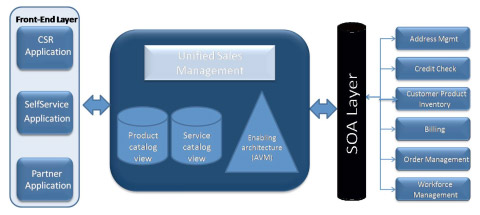
article page
| 1 | 2 | 3 | 4 | 5 | 6 | 7 |ConceptWave deploys Unified Sales Management as illustrated below.
As shown here, ConceptWave uses a SOA layer to create a common interface to a number of back-end systems. On the front end, ConceptWave’s unified transaction processing and rules engine creates a single product catalog and service catalog view, including catalog management functionality. Importantly, the same unified view can be used for many purposes: personalization on the retail side, customized offers for enterprise customers, as well as unifying multiple services into a single offer or product. Not shown explicitly here are a number of enabling architectural components, including ConceptWave’s unique “AVM” architecture, which supports the use of templates, configuration components, SOA integration, performance requirements, and other features discussed below.
|
|
There are also a number of strategic issues that CSPs must address. |
|

Pre-Defined Functionality Speeds Deployment, Increases Consistency
Both the front- and back-end solutions can benefit further if best-practices experience from other implementations can be propagated to new deployments and improved upon. Ideally, on the “back end”, an existing, documented, supported SOA query interface is made available and need only be integrated with the other systems with which it is communicating, saving months, if not years, of development work.
Similarly, on the front end, rather than have to construct and then QA a vast amount of content for CSRs, direct customers, partners, personalized viewers, and so on, presentation layer content can be created nearly
|
|
|
|

ConceptWave Internals
Internal to ConceptWave’s solution is metadata application leveraging a SOA bus, along with enabling components that allow rapid configuration of enterprise systems. Importantly, this architecture replaces integration and customization activities that would otherwise require developing new software—a time-consuming and risk-prone activity that requires specialized resources—with configuration using a simplified language and/or a GUI tool.
This move towards configuration is an important trend in enterprise systems in many different verticals; ConceptWave is pioneering this configuration-centric approach in the telecommunications market.
This approach removes complexity and inaccuracy from both supplying the customer-facing systems with accurate data for both the chosen product and for the order itself, and ensuring that data collected in orders is easily and accurately passed to the back-office systems required to fulfill an order.
|
|

automatically from pre-defined “templates”, which are then filled in with the comprehensive catalog, and business rules, again saving considerable time and dramatically reducing the need for custom programming. Under this approach, creating an order entry and product / service catalog system that is highly customized to meet a given operator’s specific needs is reduced from a months-to-years scale task, to a weeks-to-months task. Furthermore, the open nature of the templates makes their configuration a task well suited to in-house resources, rather than mandating the participation of the software vendor. Again, ConceptWave’s architecture provides a mechanism that allows such pre-defined templates to be used.
Creating a Unified Product Catalog from Multiple Distributed Systems
As shown above, ConceptWave’s architecture supporting unified sales management connects to multiple systems containing product and service catalog data, resulting in a centralized view of the catalog, which is based on data
article page
| 1 | 2 | 3 | 4 | 5 | 6 | 7 | |
|




